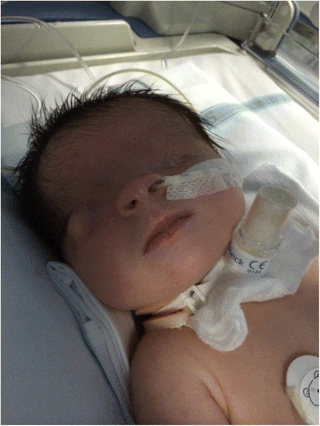Related Research Articles
Renal agenesis is a medical condition in which one (unilateral) or both (bilateral) fetal kidneys fail to develop.

MASA syndrome is a rare X-linked recessive neurological disorder on the L1 disorder spectrum belonging in the group of hereditary spastic paraplegias a paraplegia known to increase stiffness spasticity in the lower limbs. This syndrome also has two other names, CRASH syndrome and Gareis-Mason syndrome.
Potter sequence is the atypical physical appearance of a baby due to oligohydramnios experienced when in the uterus. It includes clubbed feet, pulmonary hypoplasia and cranial anomalies related to the oligohydramnios. Oligohydramnios is the decrease in amniotic fluid volume sufficient to cause deformations in morphogenesis of the baby.

A uterine malformation is a type of female genital malformation resulting from an abnormal development of the Müllerian duct(s) during embryogenesis. Symptoms range from amenorrhea, infertility, recurrent pregnancy loss, and pain, to normal functioning depending on the nature of the defect.
Agenesis of the corpus callosum (ACC) is a rare birth defect in which there is a complete or partial absence of the corpus callosum. It occurs when the development of the corpus callosum, the band of white matter connecting the two hemispheres in the brain, in the embryo is disrupted. The result of this is that the fibers that would otherwise form the corpus callosum are instead longitudinally oriented along the ipsilateral ventricular wall and form structures called Probst bundles.

Fraser syndrome is an autosomal recessive congenital disorder, identified by several developmental anomalies. Fraser syndrome is named for the geneticist George R. Fraser, who first described the syndrome in 1962.
Vaginal atresia is a condition in which the vagina is abnormally closed or absent. The main causes can either be complete vaginal hypoplasia, or a vaginal obstruction, often caused by an imperforate hymen or, less commonly, a transverse vaginal septum. It results in uterovaginal outflow tract obstruction. This condition does not usually occur by itself within an individual, but coupled with other developmental disorders within the female. The disorders that are usually coupled with a female who has vaginal atresia are Mayer-Rokitansky-Küster-Hauser syndrome, Bardet-Biedl syndrome, or Fraser syndrome. One out of every 5,000 women have this abnormality.
Asymmetric crying facies (ACF), also called partial unilateral facial paresis and hypoplasia of depressor angula oris muscle, is a minor congenital anomaly caused by agenesis or hypoplasia of the depressor anguli oris muscle, one of the muscles that control the movements of the lower lip. This unilateral facial weakness is first noticed when the infant cries or smiles, affecting only one corner of the mouth and occurs on the left side in nearly 80% of cases.

Caudal regression syndrome, or sacral agenesis, is a rare birth defect. It is a congenital disorder in which the fetal development of the lower spine—the caudal partition of the spine—is abnormal. It occurs at a rate of approximately one per 60,000 live births.

Asplenia with cardiovascular anomalies, also known as Ivemark syndrome and right atrial isomerism, is an example of a heterotaxy syndrome. These uncommon congenital disorders are characterized by defects in the heart, spleen and paired organs such as the lungs and kidneys. Another name is "asplenia-cardiovascular defect-heterotaxy".

Acrocallosal syndrome is an extremely rare autosomal recessive syndrome characterized by corpus callosum agenesis, polydactyly, multiple dysmorphic features, motor and intellectual disabilities, and other symptoms. The syndrome was first described by Albert Schinzel in 1979. Mutations in KIF7 are causative for ACLS, and mutations in GLI3 are associated with a similar syndrome.

Renal cysts and diabetes syndrome (RCAD), also known as MODY 5 or HNF1B-MODY, is a form of maturity onset diabetes of the young.

Fryns syndrome is an autosomal recessive multiple congenital anomaly syndrome that is usually lethal in the neonatal period. Fryns (1987) reviewed the syndrome.
Oculocerebrocutaneous syndrome is a condition characterized by orbital cysts, microphthalmia, porencephaly, agenesis of the corpus callosum, and facial skin tags.

Maxillary lateral incisor agenesis (MLIA) is lack of development (agenesis) of one or both of the maxillary lateral incisor teeth. In normal human dentition, this would be the second tooth on either side from the center of the top row of teeth. The condition is bilateral if the incisor is absent on both sides or unilateral if only one is missing. It appears to have a genetic component.
Müllerian duct anomalies are those structural anomalies caused by errors in Müllerian duct development as an embryo forms. Factors contributing to them include genetics and maternal exposure to substances that interfere with fetal development.

Vaginal anomalies are abnormal structures that are formed during the prenatal development of the female reproductive system and are rare congenital defects that result in an abnormal or absent vagina.
References
- ↑ Steadyhealth: Ivemark's syndrome Archived February 25, 2008, at the Wayback Machine
- ↑ Ivemark, Biörn I., Implications of agenesis of the spleen on the pathogenesis of cono-truncus anomalies in childhood: An analysis of the heart malformations in the splenic agenesis syndrome, with fourteen new cases, Diss. Stockholm : Karol. inst., Stockholm, 1955; LIBRIS record